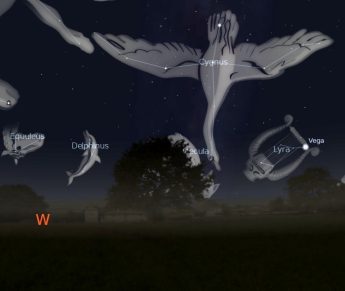This Week’s Sky at a Glance, 2024 Dec 28 – 2025 Jan 4
This Week’s Sky at a Glance, 2024 Dec 28 – 2025 Jan 4
This time of year the brilliant winter constellations really catch the eye, but this is also a good time to revisit some favourites of the past seasons. If you have a good view to the north, go out around 8 pm to observe two of the best known asterisms in the sky. To the northwest the Northern Cross stands upright, with its base star Albireo about ready to set. The cross forms most of Cygnus the Swan, now making its signature dive into what I hope is an unfrozen lake. To the northeast, the Big Dipper stands on its handle. In a rural area you can probably see the rest of the stars that make up the Great Bear, Ursa Major.
Stretching overhead are the autumn constellations of Cassiopeia, Andromeda and Perseus. With binoculars look for a miniature version of Draco around the brightest star in Perseus; the galaxy M31 in Andromeda; and if you draw a line across the tips of the W of Cassiopeia and extend it by about the same distance into faint Camelopardalis you might chance upon a string of about 20 stars called Kemble’s Cascade. From a dark area, try to pick out the Milky Way running from Cygnus through Perseus and the feet of Gemini, to Canis Major in the southeast.
This Week in the Solar System
Saturday’s sunrise in Moncton is at 8:01 and sunset will occur at 4:41, giving 8 hours, 40 minutes of daylight (8:03 and 4:49 in Saint John). Next Saturday the Sun will rise at 8:01 and set at 4:47, giving 8 hours, 46 minutes of daylight (8:03 and 4:55 in Saint John). The Earth is at perihelion, its minimum distance from the Sun, next weekend.
The Moon is new on Monday and near Venus at noon on Friday, a good opportunity to see Venus in daylight. Look for it above the Moon with binoculars and then try to see it with just your eyes. The following day it cruises just below Saturn between noon and 1 pm; try for Saturn with a telescope. Mercury rises around 6:30 midweek and is seen easily low in the southeast with binoculars, and without when you know where to look. On Thursday evening telescope and binocular users might see Jupiter’s moon Ganymede disappear behind the planet at 5:53 pm and emerge at 8, and then enter Jupiter’s shadow at 8:26 and emerge at 10:44. Mars is brightening as it retrogrades through Cancer, heading toward opposition in mid-January. The short-lived Quadrantid (Bootid) meteor shower is near its peak on Friday morning, with meteors emanating from below the handle of the Big Dipper.

